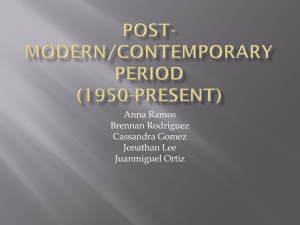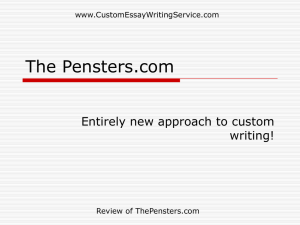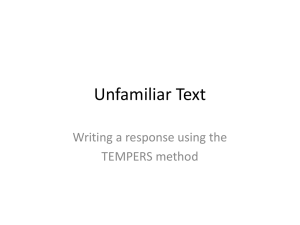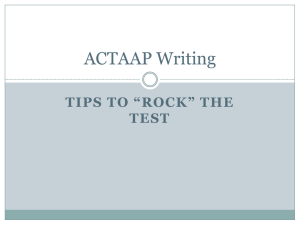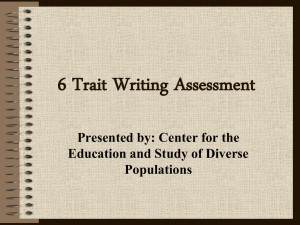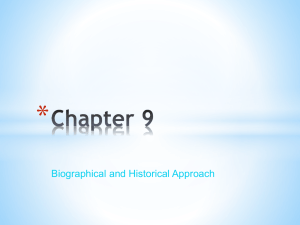Unfamiliar Answers - HillcrestHighEnglish
advertisement
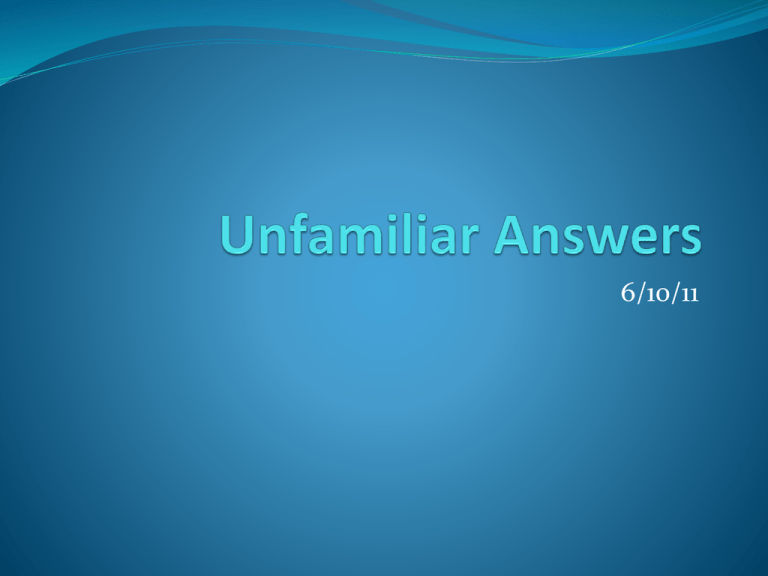
6/10/11 Written Text – “Lip Service” Q1: Identify ONE generalisation that the writer suggests about what it means to be a New Zealander, AND explain how the writer develops this idea with a particular audience in mind. Begin with an overall statement like… A: One generalisation suggested by the writer about what it means to be a New Zealander is New Zealanders’ fear of intimacy. The writer describes it as a “hard-wired reluctance to touch” that New Zealanders struggle to overcome. This idea is developed in the writer’s use of first-person narrative voice, anecdotes and simile to target the self-deprecating rural New Zealander who can see the humour in their own shared reactions and behaviours. Then go on to explain the techniques used in relation to the question… - First-person narrative voice, as seen in lines such as “(Was that too much? It was, wasn’t it? I shouldn’t have done that…).” By blending a personal monologue into the article, the writer helps us to recognise our own reactions to awkward situations and thereby see the shared humour in our fear of intimacy. This very personal writing voice makes us aware that we are not alone in these odd, uncomfortable thoughts about what is/isn’t appropriate when meeting someone. - Anecdotes, like the story about when “I dated a builder who jutted his chin at his mates”, helped build an intimacy and almost establishes this writer as a friend with whom we can share our fears and awkwardness. The anecdote also helps us see the humour again in the actions of people we may know or see each day. The ability to laugh at oneself is a quality appreciated by many New Zealanders and is often seen as part of our charm and genuine nature. Anecdotes like this one suggest the writer is someone who knows us well. - The simile of “going straight to the kiss is like clamping a colander over a butterfly” comparing the trapping of a butterfly to planting a kiss on everyone you meet reveals the writer’s opinion, which many New Zealanders seem to share, that we would rather admit to a fear of intimacy than lose our slight physical reluctance. And if you haven’t already done so in explaining the techniques, sum up your response… These techniques used by the writer reveal her obvious knowledge, and likely shared background, of New Zealanders as a group. Her target audience recognises the sense of humour, similar honesty and the social references that build a common origin to the writer herself. This is how you structure an Excellence response! Q2: The writer deliberately creates several tones in this text. Three of these are humour, nostalgia (thinking fondly about the past) and persuasion. Choose ONE of these tones, and analyse in detail how the writer uses techniques to create this tone. A: The writer deliberately creates a persuasive tone in this text. This helps the audience realise their shared flawwhich, after reading this article, we are supposed to see is a part of our New Zealand identity. Techniques such as exaggeration, repetition and listing are used to persuade us to admit and accept our shared characteristic. - Exaggerated comparisons – like our process of meeting a friend being compared to a game of Battleship (as seen in the idea that there need to be “simple rules of engagement”, and “approach opponent”) – makes us appreciate the silliness, but also the strategy, behind our greetings. To suggest that a physical meeting is in any way similar to going to war exaggerates the fear that the writer generalises New Zealanders all feel. By using this ridiculous comparison, the writer does persuade us to see the humour in the habits, like the builder’s chin-jut, that can mean so much. - Repetition of the phrase “fear of intimacy” – (line 16 & 18) – works to persuade us that we should recognise and embrace this quality in our national identity. Further references to ‘fear’, such as being ‘neurotic’, and as if in a ‘trap’, along with references to intimacy, touching and kissing – force us to face up to the so-called “good old New Zealand fear” that we have. The repetition works on us to persuade us that we cannot escape the habit of fearing intimacy and should not even try – as it is a part of who we are as a nation. - Listing is a further technique that works to persuade us that we do not want to get past of give up on our fear of intimacy. The writer suggests that if we do lose it, a precious aspect of our identity may be lost, in a fashion similar to the loss of “the glass milk bottle, the Snifter and the Hillman Hunter”, and that it will “slowly fade into legend”. By listing these so-called legendary things, the writer works to persuade us that this interesting and possibly endearing stand-offish quality is something that makes us special and unique; and, rather than lose it, we should embrace it and claim it as a part of who we are. Written Text Poetry – “Three Cranes in a Dock” Q1:Explain how the poet’s comparison of mechanical cranes to birds develops your understanding of the poem. A: SIMILE: Early in the poem, the writer compares the mechanical cranes to birds through the use of simile, “three cranes bow their girdered necks east as if in prayer”. This comparison allows the reader to imagine the bird-like mechanical cranes with long necks hanging low; not only are they compared with birds, they are made more romantic with the idea that they are bowing “as if in prayer”. This simile creates a closeness between the cranes and the harbour in which they work, suggesting that they are not that far removed from the natural aspects of the sea, sand and harbour. In the physical description of the mechanical cranes offered by the writer, we recognise the similarities in the two cranes being compared – their long necks, their geographical placement living by the water’s edge and their long limbs. These details help build an image and allows their mechanical nature to almost be overlooked. METAPHOR: Later, when the image is developed with the metaphorical description of their place of rest as a ‘nest’, the reader is almost convinced they are part of nature, waiting for daylight so they can leave the ‘nest’ and venture out into the world. The final development is established with the description of them waiting to “hatch their legs in the lengthening day”. By using the word, ‘hatch’, the writer has again chosen a word we associate with birds’ nests – chicks being born, a natural process of baby birds beginning their lives. This comparison of mechanical cranes to birds has evolved throughout the poem and now the reader has to work hard to remember these birds are not part of nature, they are a part of the human world – made of metal. However, it is far more comfortable to imagine them as a part of the natural world as they live and work on the shoreline. The writer has worked to help us see the lose connection, but also the differences, in these two aspects – nature and advancement. There is a suggestion that there is something natural and beautiful about the way the cranes look and act – as if nature would accept these creatures despite their “girders” and mechanical “wired” natures. Q2: Analyse how sound, image and mood work together at the beginning (lines 1-4) and at the end of the poem (lines 17-18), AND explain how and why a contrast is created. At the beginning of the poem, sound (sibilance), image (personification) and mood (heavy vowel sounds) work together to create a gentle, natural start to the morning. The heaviness of the repeated “d” sound in “dawn”, “drains” and “dropping dregs”, offers a slow-just-waking-up sensation to the movement. The tide’s sibilance in the repeated “s” in the “slope of shells”, mimics the sound created by the waves gently pushing sand and shells across each other. These, combined with the personified image of the tide throwing a hush across the “sandy shoulders” of the harbour, make it seem as if the harbour is a person slowly waking in the morning, pulling themselves out of a deep sleep. In contrast, the end of the poem has shifted from the nature-based sounds and images into louder and more mechanical comparisons. The sounds in the final two lines include the onomatopoeia “bang” and “clang” – two loud jarring sounds that occur when metal bumps against metal. Imagery at the end of the poem also echoes this jarring, mechanical quality, with the use of controlling images – described as a “fence” and “chain” to hold things in. While the initial scene is still and natural, the final scene is louder and human. The contrast is connected through the idea of the cranes as birds – the reader is drawn in by the idea of nature, but this evolves into the images of human advancement as cranes ready themselves to lift and transfer pallets and crates. Interestingly though, the mood in the ending is lighter, with the positive word “hopeful” being the only emotive word in the final lines. This seems to suggest the cranes are keen to begin moving and began preparing themselves once they heard the sounds of human movement begin with the bang and clang and the “kettle being boiled” – as a morning cuppa is being made. Visual Text – “The Captive Wife” Q1: Analyse how the visual aspects of the book cover connect with the title The Captive Wife to suggest detailed ideas about the content of the book. You could consider the use of colour, image, symbolism, and layout. The use of symbolism and layout reveal ideas about the content of Fiona Kidman’s novel The Captive Wife. Two strong symbols support the growing fear and uncertainty the reader has regarding the wife’s wellbeing. The first is the white dove, seemingly trapped within the curved shape of the letter “C”, suggesting that hope (which is symbolically represented by a dove in religious stories) cannot be felt or experienced in this text. Secondly, the female figure on the prow of the boat visually appears trapped within a net of ropes – with the ropes casting shadows across her face, essentially imprisoning her. This suggests a physical entrapment of the woman who titles the novel. The layout of the title also supports the imprisonment of the wife and foreshadows ominously harsh treatment of her. The word “CAPTIVE” is in capital letters, in a banner-headline style, and as it is the largest word on the cover page, the reader cannot escape its negative associations and is prepared for the worst. With the smaller text “WIFE” pushed across to the right-hand side of the page under the word ‘captive’, the common noun loses any positive connotations and becomes a passionless label rather than a term of endearment or relationship. Seeing the trapped female figure directly below the title, readers cannot help but be aware that this novel will probably focus on the bleak life of a woman who is trapped – possibly by society and its expectations and probably by her husband and what he wants. Oral Text – “More Fish, Less Drought” Q1: Analyse in detail how the speaker uses language techniques to persuasively develop ideas for his audience. A: The speaker, Mr English, works hard to persuade his audience that they must act to make water a more sustainable resource and recognise it as the ‘treasure’ it is. His early historical reference to the artist and philosopher Leonardo da Vinci’s comment that, “water is the driving force of all nature”, is a persuasive opener, as it highlights the idea that without water all life would cease to exist. Even hundreds of years ago when da Vinci was writing his ideas, it was obvious that water was at the heart of living and Mr English is amazed that we still are not doing enough to protect this natural resource. This use of history to prove a point should persuade people that we need to act now; we have waited long enough without acting effectively. The repeated use of inclusive personal pronouns works to show how we have a shared interest in making water safe and sustainable. “As farmers we harness nature, we harvest it for our families and society, and we nurture it for future generations”. By repeating “we”, the speaker reminds the audience of their shared interests and livelihoods, and when this combines with the possessive pronoun “our”, the audience cannot help but recognise the need for collaborative action. Later, the inclusive pronouns are contrasted by the speaker’s use of exclusive pronouns to highlight differences between our situation and the problems in third-world nations, and even in Australia, where ‘they’ have to “look underground for their treasure”. Our situation is different and therefore we need to act differently to protect our resource. The metaphor used to describe our water supply as a ‘treasure’ helps to communicate the seriousness of Mr English’s concerns and the value of water in our lives. Treasure is typically associated with things that are highly desirable and valuable – like jewels or precious stones. In this case, water is the treasure that we must ‘harness’ and protect for the benefit of “the environment and the whole nation”. This comparison works well to persuade the audience that water must be protected, as treasure is something we can all understand, and once we accept that without water we are in trouble, its value becomes obvious to us all.

